Your Guide to Virtual Shopping Assistants and Why You Need One for Your Store

Virtual shopping assistants are one of the biggest trends in ecommerce.
If you’ve done any shopping online in the past few years, you’ve likely interacted with a virtual shopping assistant. These are the AI-powered chatbots that pop up as an on-site widget or in your text messages to provide guidance for your purchasing decisions. This allows ecommerce merchants to offer 24/7 support and upsell customers at a much lower cost than human agents.
Customers benefit from virtual shopping assistants as well; this technology ensures that they always have access to help whenever they need it.
In this guide, we’ll go over these benefits and others in more detail. We’ll also cover popular use cases for virtual shopping assistants, provide examples of brands successfully implementing them and show you a number of solutions you can use to create your own virtual shopping assistant.
#cta-visual-pb#<cta-title>Create any page type for your ecommerce store<cta-title>Build more successful landing pages with Shogun’s customization options. Learn more
What is a Virtual Shopping Assistant?
A virtual shopping assistant is a software solution that uses machine learning and natural language processing technology to facilitate text-based interactions with online visitors. It can perform a variety of tasks, including answering questions, making product recommendations and providing order information.
Virtual shopping assistants have been gaining in popularity in recent years. We’ve seen brands like Sephora, H&M and LEGO implement them on their websites and social media pages with great success. Overall, virtual shopping assistants are part of a broader trend, along with voice commerce, of AI changing the way that people shop online.
And advances in AI technology have made virtual shopping assistants quite effective. They’re now able to answer up to 80% of routine questions, and 34% of online shoppers even prefer chatbots over human support agents.
How Does a Virtual Shopping Assistant Work?
On the surface, the workings of a virtual shopping assistant are quite simple. To interact with an assistant, a user first needs to visit a brand’s website or social media page.
The virtual shopping assistant then greets the user and asks a question or lets the user know about a particular promotion or offer. The greeting, question and offer can be personalized based on data available on the user or kept generic to apply to all visitors.
Users can then interact with the assistant, get answers to their questions and, hopefully, make a purchase.
Benefits of Implementing a Virtual Shopping Assistant
Now that you know exactly what virtual shopping assistants are and how they work, let’s dive deeper into the benefits that they offer your business.
There are many ways in which virtual shopping assistants can be used to improve your bottom line, such as:
- Gather data: You can find out more about your customers and their preferences, and then use that information to have an easier time selling to them. The conversion rate of personalized recommendations is 5.5 times higher than the conversion rate of the average visitor.
- Save money: A virtual shopping assistant can help you save money by relieving you from having to hire a dedicated live chat support team, as well as reducing the number of inquiries your existing support team gets on a daily basis. You can direct these savings straight into your profits or use them to build up the other areas of your business and foster future growth.
- Gain a competitive advantage: If none of your competitors are offering virtual shopping assistance to their customers, you can stand out by implementing an assistant for your online store. And if your competitors are already using virtual shopping assistants, you’ll need to catch up with them in order to regain your competitive edge.
- Provide a better customer experience: A virtual shopping assistant allows you to communicate with customers, as well as enables you to provide them with 24/7 support. In the long term, this will help you convince customers to stick with your service rather than leave for one of their other options, which is especially important for the financial health of your business. After all, acquiring a new customer costs five times as much as retaining an existing customer.
- Generate more sales: You can also generate more sales with the help of a virtual shopping assistant by providing product recommendations and sending abandoned cart reminders to your customers. Remember, nearly 70% of carts are abandoned. By using a virtual shopping assistant to send out these reminders, you’ll be able to get many potential customers to follow through and complete their purchase.
What Can a Virtual Shopping Assistant Do?
When virtual shopping assistants were first developed, they weren’t able to do anything other than answer a few basic questions. But now, this technology is capable of addressing many different customer needs.
Here’s an overview of what they can offer current and potential customers:
1. Answer Questions

One of the most common uses of virtual shopping assistants is to provide answers to customers’ questions.
Companies often utilize assistants to act as a kind of live FAQ page, where users can get answers to some of the most commonly asked questions on the brand and its products. For most businesses, this includes questions on shipping costs, delivery time and refund policy. Brands that have physical locations will naturally get questions on store locations and work hours as well.
Virtual shopping assistants can also be coded to provide answers to a variety of product-specific questions, including those on product material, sizing or warranty.
2. Provide Order Information

After making an online purchase, the main thing shoppers want to know is when their order will arrive.
While sending this information via email is one option, providing it through an assistant should also be considered, too. This simplifies things for customers and helps to keep them on the website longer so that they can potentially make another purchase.
A virtual shopping assistant enables brands to let their customers know when they can expect to receive their package, as well as share other useful details on a customer’s order, such as tracking information.
3. Make Product Recommendations

Virtual shopping assistants can also be used to make product recommendations based on customers’ needs, behavior or preferences. You can use an assistant to learn more about the type of product a customer is looking for, and then tailor recommendations to suit their needs. This can significantly improve the customer experience you provide by enabling customers to find the best solution to their problems as quickly as possible.
4. Offer Deals and Coupons

There’s also the option of using a virtual shopping assistant to offer deals and coupons to shoppers. This can be used in a variety of different ways to improve conversion rates and generate more sales and revenue.
Brands can use an assistant to offer first-time customers a welcome discount, promote seasonal offers, as well as provide product-specific discounts. A virtual shopping assistant can also be coded to offer customers a discount once they try to leave the website without making a purchase.
5. Send Abandoned Shopping Cart Reminders

The majority of online shopping carts are abandoned before customers complete checkout. A virtual shopping assistant can be used to recover some of these carts and boost your business’ revenue.
Depending on where you place your assistant, it can remind shoppers of what they left in their cart once they revisit your website or one of your social media pages. These types of abandoned cart reminders have shown to be more effective than abandoned cart emails, achieving as much as 33% higher conversion rates.
#cta-visual-pb#<cta-title>Create any page type for your ecommerce store<cta-title>Build more successful landing pages with Shogun’s customization options. Learn more
5 Examples of Companies Using Virtual Shopping Assistants
In this section, we’re going to go over some examples of brands using virtual shopping assistants successfully.
Burberry
Burberry was one of the first luxury fashion brands to implement a virtual shopping assistant back in 2016. The assistant was initially meant to provide customers a behind-the-scenes look of the brand’s collection shown at New York Fashion Week.
The brand has since improved the assistant to allow customers to use it to locate physical stores, get in touch with a Burberry consultant and make purchases.
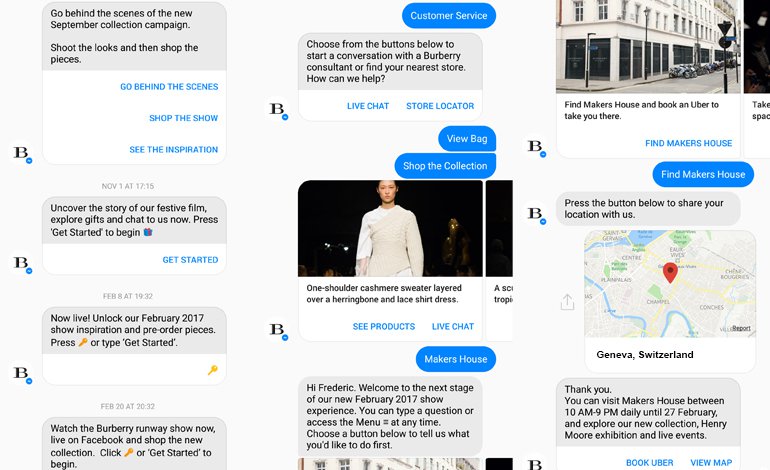
Sephora
Sephora’s virtual shopping assistant can help customers find the right products for their needs while taking into account any preferences they might have. After identifying the right product for a particular customer, the assistant directs the customer to Sephora’s website, where they can complete their purchase.
Sephora has a couple of other separate virtual assistants, which can help customers book reservations with a beauty specialist at Sephora, as well as test out different makeup color combinations with the help of augmented reality technology.
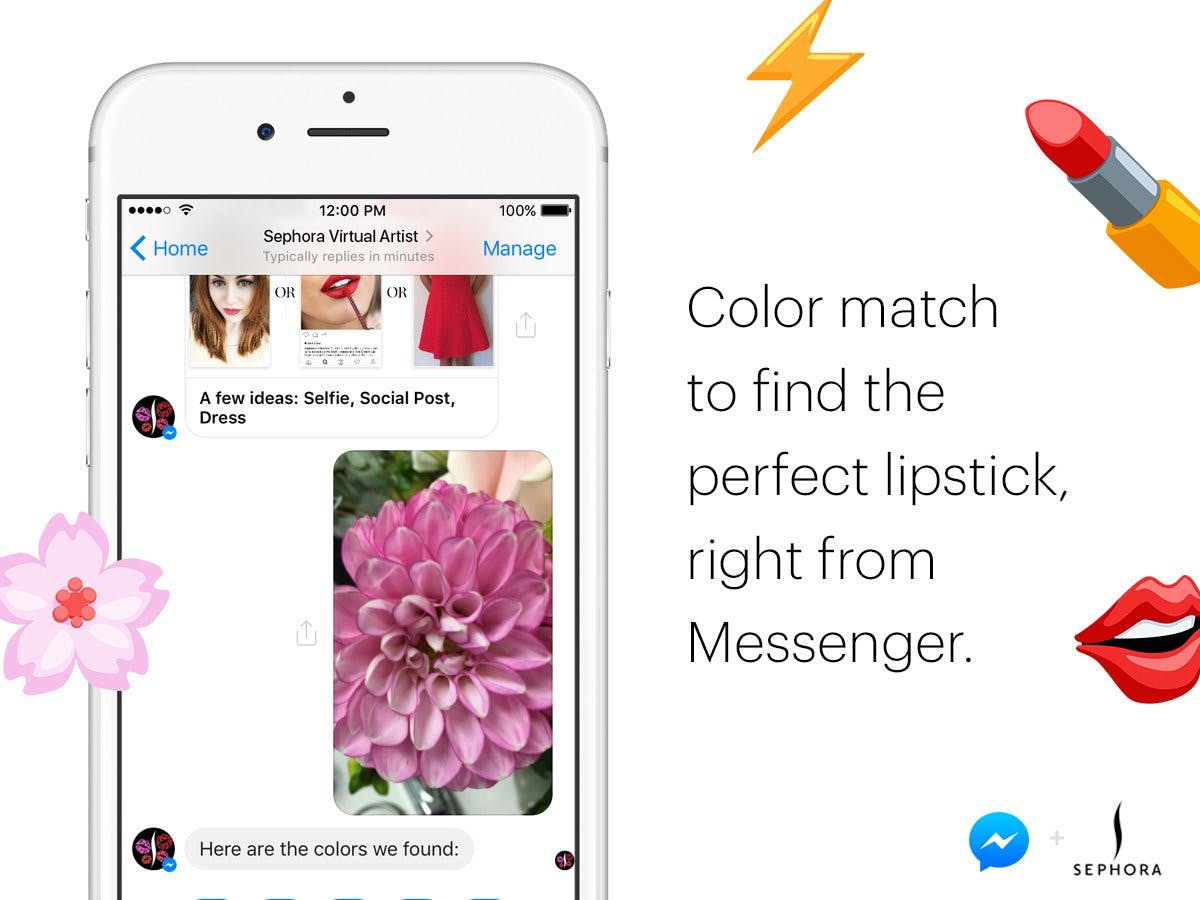
H&M
The H&M virtual shopping assistant is designed to ask a series of questions to learn more about a shopper’s style, and then recommend outfits and products that align with the shopper’s preferences. It also allows shoppers to create their own outfits, and view and save outfits created by other users.
With each outfit suggestion, shoppers can visit the associated product page with a single tap.
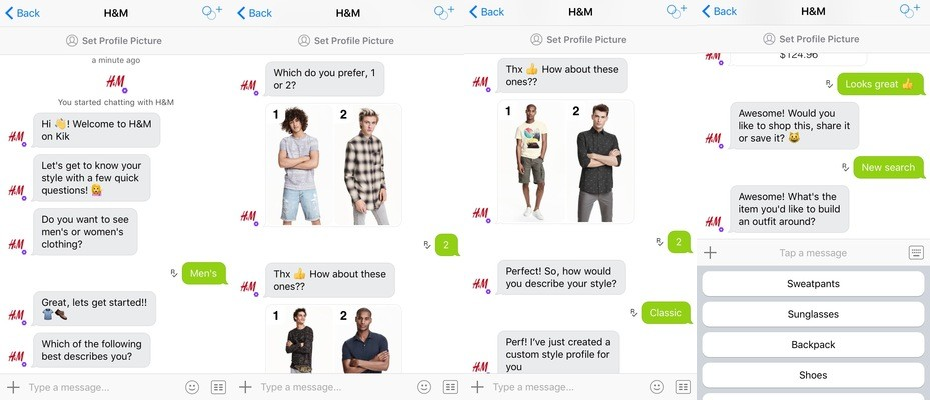
LEGO
LEGO has a virtual shopping assistant that helps its customers choose the right gift for their loved ones. It was created to make it easier for customers to choose a product from LEGO’s vast product catalog.
The assistant asks the user a series of questions to learn more about the person the gift is for, as well as the budget available for purchasing the gift. Using this information, it makes a personalized product recommendation and gives the user a link where they can buy the product.
LEGO’s assistant helped the brand achieve a 600% return on ad spend in certain markets and drove 25% of all in-season online sales.
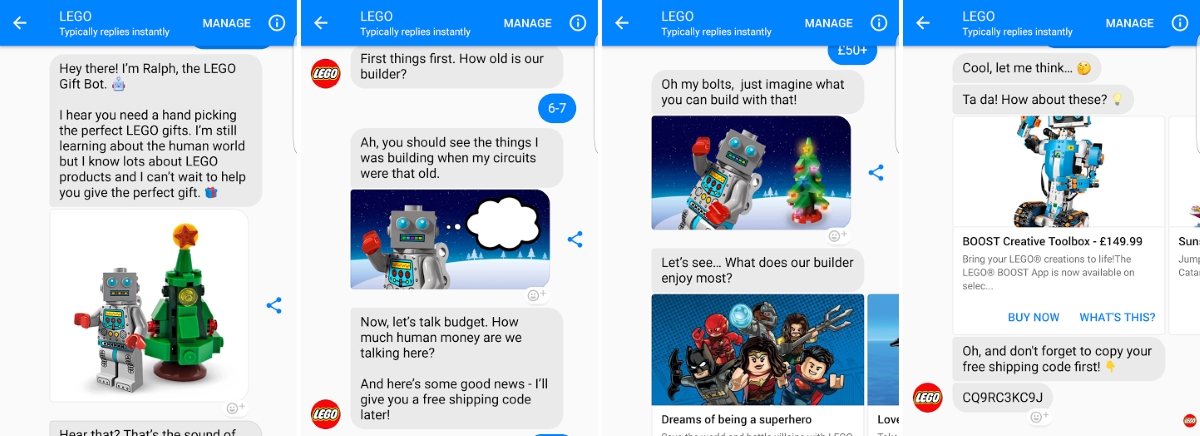
Levi’s
Levi’s uses a virtual shopping assistant that is available through the brand’s website and via Facebook Messenger. It’s designed to help shoppers find the best-fitting pair of jeans for themselves.
The assistant asks a series of questions to learn more about shoppers’ preferences, and then uses the answers to formulate personalized product recommendations. It manages to make up for the lack of assistance and fitting help customers would receive in-store by taking advantage of specialized technology to provide accurate recommendations on sizing.
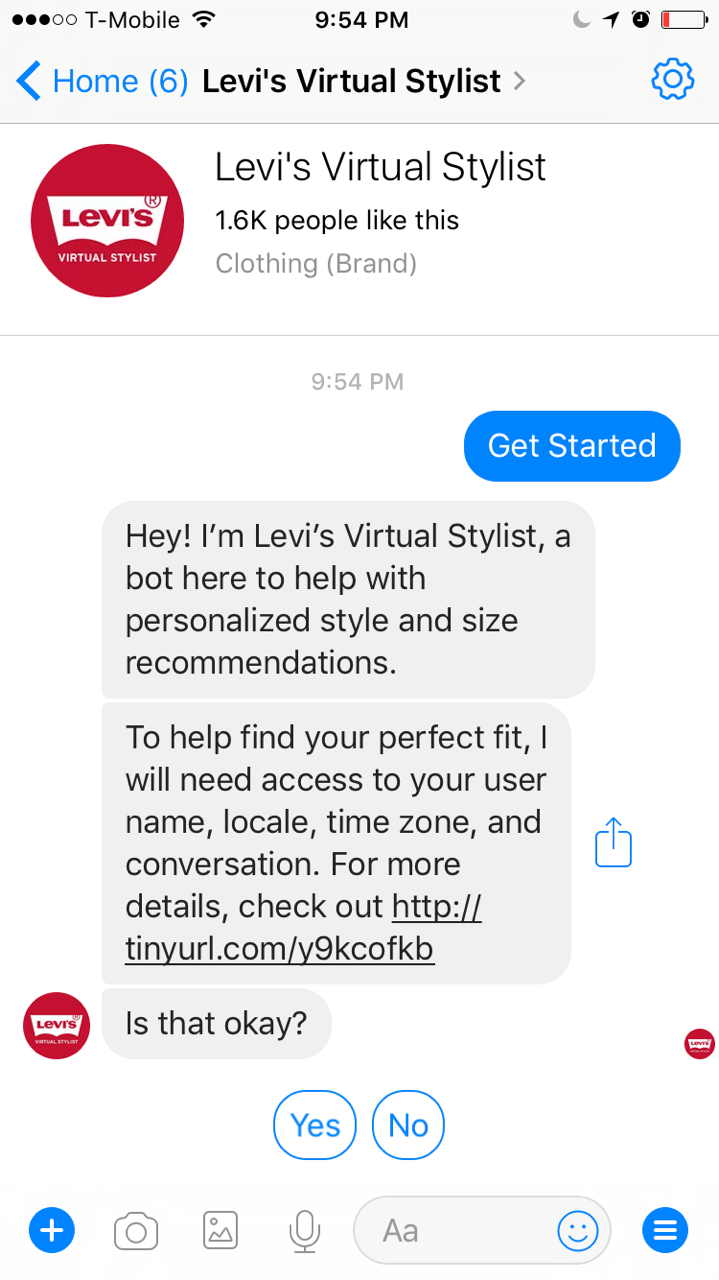
5 Virtual Shopping Assistant Solutions
Ready to create a virtual shopping assistant for your online store? Here are five virtual shopping assistant solutions you can use to implement an assistant today.
1. Bold360
Bold360 is a solution that integrates a virtual shopping assistant with human live chat agents. It’s designed for enterprise businesses handling a large volume of traffic and sales. The platform requires very little setup and can be used almost instantly. It takes advantage of AI and natural language understanding (NLU) technology to facilitate natural conversations with customers.
Bold360 is used by companies such as The North Face and Zalando. Pricing information for this app is not publicly available, so you’ll need to contact Bold360 for a quote.
2. ManyChat
ManyChat is a software solution designed to help businesses create virtual shopping assistants on Facebook Messenger. It uses a drag-and-drop template system which allows brands to create sophisticated virtual assistants with ease. ManyChat integrates with a variety of popular business solutions, including Shopify, Zapier, HubSpot, ActiveCampaign and Klaviyo.
ManyChat is used by more than 1 million businesses across 190 countries. There’s a free version of ManyChat that offers all the basic features you’ll need, as well as a premium version that costs $10/month and offers extra features such as A/B testing, buy buttons and email marketing.
3. Chatfuel
Chatfuel supports the creation of virtual shopping assistants on Facebook Messenger. It’s been used by companies such as Adidas, Levi’s and LEGO to reduce cost per conversion, boost return on ad spend and generate more sales.
Chatfuel offers a free plan that’s limited to 50 users. Paid plans start at $15/month and include priority support, A/B testing and abandoned cart reminders.
4. MobileMonkey
MobileMonkey is a popular solution for creating virtual shopping assistants. It supports automated sequences, retargeting and live chat handoff through Zapier.
The platform uses a drag-and-drop interface that allows businesses to create their own virtual shopping assistant with ease. MobileMonkey offers a free plan that includes 1,000 monthly credits. Paid plans start at $9/month.
5. Octane.ai
Octane.ai is a virtual shopping assistant solution designed specifically for DTC brands. It supports website pop-ups, abandoned cart reminders, shipping notifications and custom campaigns.
The platform integrates with popular ecommerce solutions, including Shopify, Klaviyo and Yotpo. Octane.ai offers a free 14-day trial you can use to try out the solution and see if it’s the right fit for you. Paid plans start at $9/month.
Start Using a Virtual Shopping Assistant Today
As brands such as Sephora and Levi’s have shown, virtual shopping assistants are a highly effective way to improve customer experience and generate more sales. And with a number of robust — and affordable — solutions available, you can easily add this feature to your store.
You’re only one quick app installation away from having a virtual shopping assistant of your own. Good luck!
#cta-visual-pb#<cta-title>Create any page type for your ecommerce store<cta-title>Build more successful landing pages with Shogun’s customization options. Learn more

Boris Mustapic
Boris Mustapic is a writer and content marketing specialist with a decade of experience in the digital marketing industry. Having built his own successful ecommerce business, he likes to share his knowledge with ecommerce enthusiasts. Apart from writing about marketing and ecommerce, Boris also enjoys a good book and a glass of red wine.



